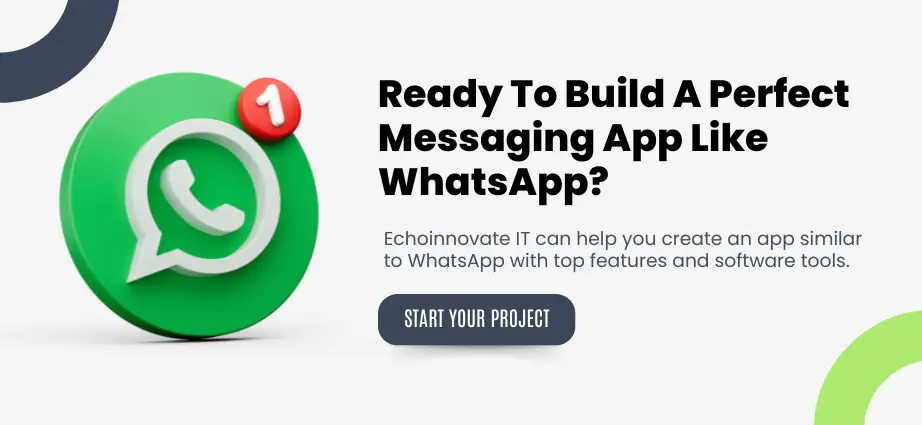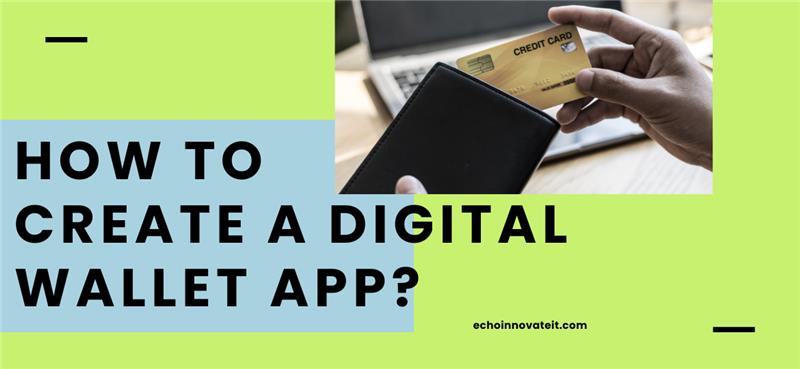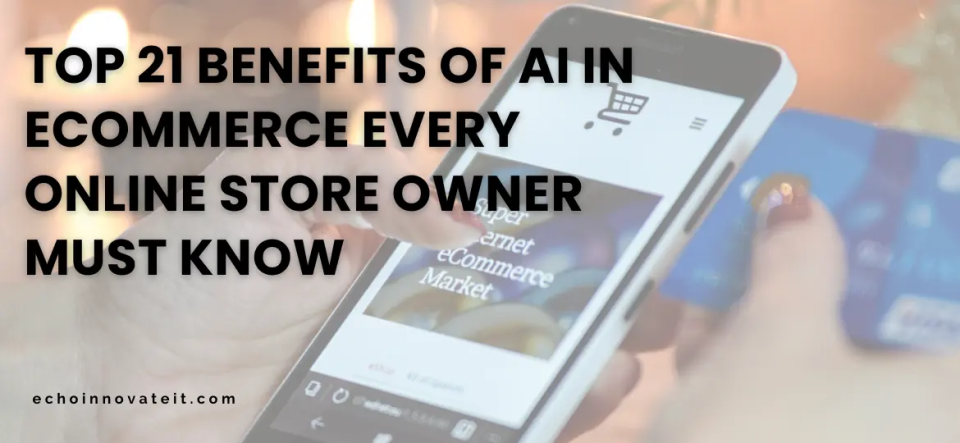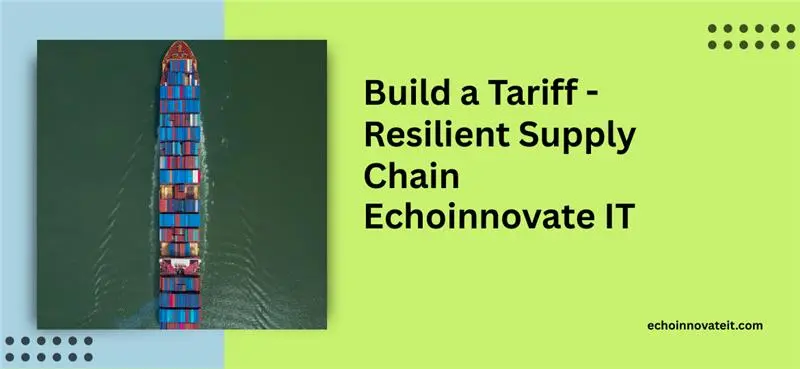How to Develop a WhatsApp-Like Messaging App in 2025: Complete Guide
Building a WhatsApp-like app in 2025 is more than just coding—it’s about creating a secure, mobile-first, and AI-enhanced digital product that engages users across Android apps, iOS apps, and web platforms. With U.S. smartphone users spending an average of 4–5 hours per day on mobile apps, investing in messaging app development is one of the most profitable tech opportunities today.
Whether you are a startup, enterprise, or B2B/B2C business in the USA, this guide explains how to build a successful app like WhatsApp by leveraging the latest SEO, AI, and mobile technology trends.
Step 1: Define Your App’s Purpose and Target Market
The foundation of your messaging app starts with a clear value proposition. Do you want to serve global users, niche communities, or professional businesses? For example:
Business Messaging Apps → Secure communication tools for enterprises
Community Apps → Local groups, sports clubs, or event-based communication
Global Consumer Apps → WhatsApp-like experiences with multimedia sharing and real-time chat
Targeting the right audience ensures your app gains traction in the competitive mobile app development market.
Step 2: Focus on Security and User Trust (E-E-A-T)
In 2025, data privacy and security are non-negotiable. U.S. consumers expect apps to demonstrate Experience, Expertise, Authoritativeness, and Trustworthiness (E-E-A-T).
Key features for trust:
End-to-End Encryption (WhatsApp standard)
Biometric Authentication (Face ID, fingerprint login)
Secure Cloud Backup
Transparent Privacy Policies
Apps that clearly demonstrate expert-led design and transparent data practices rank better on Google Play Store and Apple App Store searches—boosting visibility.
Step 3: Prioritize Mobile-First Performance
With Google’s mobile-first indexing, your app’s performance on smartphones defines success. The U.S. market favors apps that are:
Fast & Lightweight → Optimized for 5G & Wi-Fi 6 networks
Responsive on Android & iOS → Seamless experience across devices
Offline-Friendly → Local data storage for messaging when networks are unstable
Battery Efficient → Optimized background sync
Step 4: Must-Have Features in a WhatsApp Clone App
To compete in the U.S. mobile app development market, your app must include:
One-to-One & Group Messaging
High-Quality Voice & Video Calls
Status/Story Updates
Media Sharing (Images, Videos, Docs)
Push Notifications for Android & iOS
Step 5: Advanced Features to Stand Out
Adding innovative, AI-powered app features can give your WhatsApp-like app a competitive edge:
AI Chatbots & Auto-Replies
Disappearing Messages & Self-Destruct Timers
Multi-Device Sync (Mobile, Tablet, Web)
AR Stickers & Filters
In-App Payments & Digital Wallets
Voice-to-Text & Real-Time Translations
These features not only improve user experience but also drive engagement and retention—two key ranking factors on app stores.
Step 6: Tech Stack for WhatsApp-Like App Development
Choosing the right mobile app development tech stack in 2025 is crucial:
Frontend (Cross-Platform) → Flutter, React Native
Backend → Node.js, Firebase, AWS, WebSockets
Database → PostgreSQL, MongoDB, MySQL
APIs → Twilio, Agora, Stripe for payments
This ensures scalability, speed, and performance across Android and iOS apps.
Step 7: Cost of Developing a WhatsApp-Like App in 2025
In the USA, the mobile app development cost varies based on features:
MVP (Basic Features) → $25,000 – $50,000
Full-Feature App (AI, Payments, Cloud) → $100,000 – $300,000+
Ongoing Maintenance & Updates → 15–20% annually
Outsourcing to a reliable U.S. app development company or partnering with a dedicated mobile app development agency can help reduce risks.
Step 8: Monetization Models
Profitable revenue models for WhatsApp-like apps in 2025 include:
In-App Advertising
Premium Subscriptions
Transaction Fees (Payments, Wallets)
Freemium Upgrades
Business APIs for Enterprises
Step 9: Post-Launch Optimization
Once your app is live, success depends on:
App Store Optimization (ASO) for Google Play and Apple App Store
Regular Security Updates
User Feedback & Iteration
Marketing & Social Media Campaigns
WhatsApp is one of the most popular messaging apps owned by Meta. Its popularity depends on various factors like instant messaging, simple user interface, and instant file sharing (images, high-quality videos, stickers, poles, map locations, PDFs, etc). WhatsApp launched “WhatsApp Business” in 2018 to enable smaller businesses to reach clients more efficiently. WhatsApp’s availability in over 180 countries increases its potential to reach over 2.7 billion people.
Since then, WhatsApp Business has been a popular business option. Over 50 million businesses use WhatsApp for marketing purposes. WhatsApp Business is quickly becoming a requirement, particularly for e-commerce businesses. As of February 2024, it is the App Store’s top-ranked messaging app.
Have you always been curious about how chat applications like WhatsApp are designed? Developing an app like WhatsApp may seem challenging, but with the right guidance and tools, you can surely make an app like WhatsApp in 2024.
Let’s understand how…
Features To Add In Your Chat App Like WhatsApp
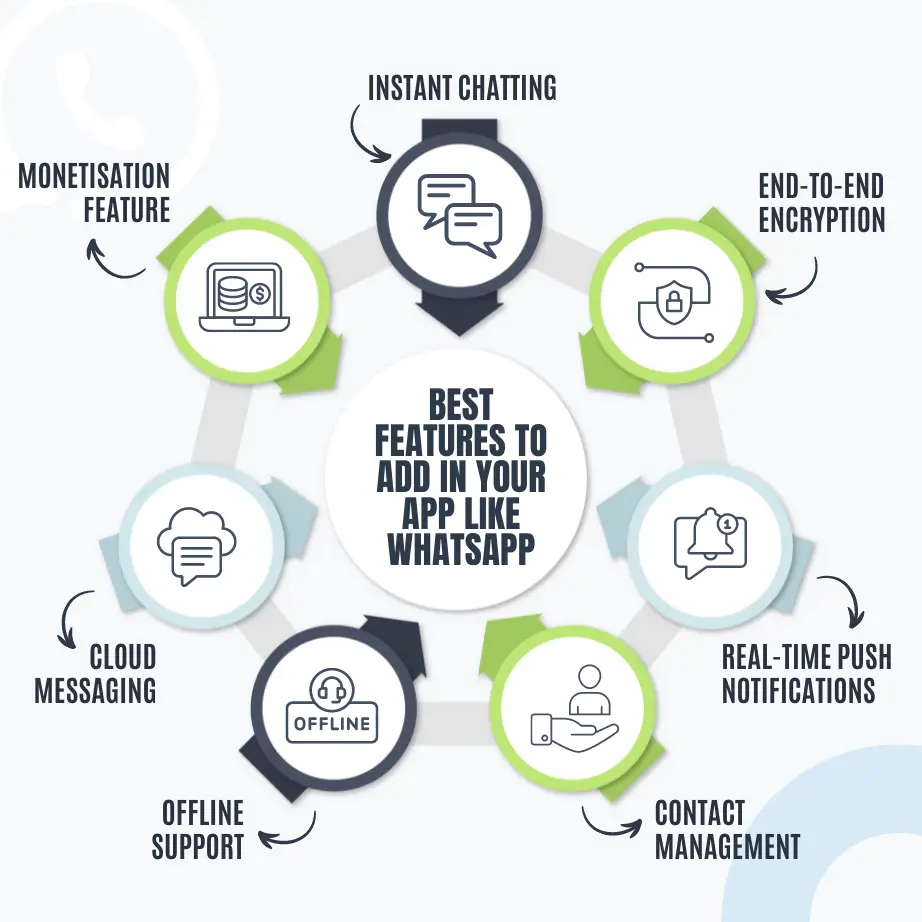
Developing an app like WhatsApp requires careful consideration of the basic features to add to your chatting application. Forget about the long lists of features or even the latest features WhatsApp continues to add every year. First, let’s understand some of the must-have features you should add to provide the best experience to your users. Let’s find out:
Also Read:
1) Instant Chatting
The primary function of any chat program is to send and receive text messages in real-time. Users should be able to converse one-on-one or in group conversations, supporting multimedia file sharing (images, videos, and documents).
2) End-to-end Encryption
As previously said, users’ primary priority is security. End-to-end encryption ensures that only the sender and receiver can see the messages, protecting user data from privacy violations.
3) Real-time Push Notifications
Real-time push notifications update users on new messages, calls, and other app-related activities. This feature promotes user involvement and timely communication.
4) Contact Management
By integrating the chat app with the user’s address book, users can easily search and communicate through their connections. The software should also allow users to add new contacts by entering their phone number or scanning a QR code.
5) Offline Support
Users should be able to view their conversation history and send offline messages. Messages can be saved locally and sent when the user returns online.
6) Cloud Messaging
Storing chat history on a cloud server allows users to view their discussions from numerous devices, giving a more seamless experience and assuring data continuity.
7) Monetisation Feature
Monetisation options such as premium features, stickers, and themes can be made available through in-app purchases, which generate revenue for the app.
Combined with a user-friendly layout and cross-platform compatibility, these features can help you build messaging software that competes with WhatsApp and Telegram.
Latest Features To Add In Your App Like WhatsApp In 2024
As a beginner in messenger app development, adding fundamental features should be your priority. Although you can learn about some of the latest features WhatsApp has brought in April 2024. Check them out:
- Two-step verification
- Edit messages
- Send photos or videos in HD quality
- Voice message status
- Companion mode
- Prevent scam/unknown callers
- Lock private chats
- React to messages through emoji
- Add description/caption with pictures, videos, or documents
- Create polls
- Status link previews
- WhatsApp communities
Architectural Design To Consider While Developing An App Like WhatsApp
The credit for every successful app goes to its robust features and combination of powerful software tools. Have you been curious about the design and architecture behind chat apps like WhatsApp? Let’s understand this in detail:
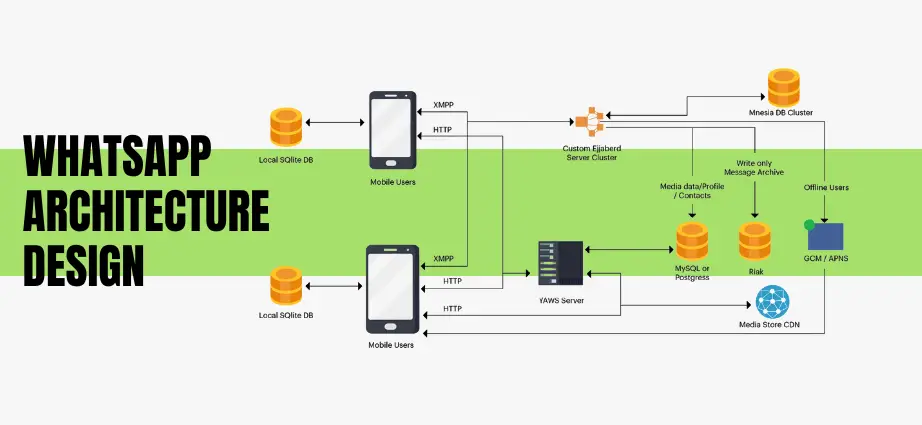
- Each mobile device contains a local SQLite database that stores user data and communications.
- Devices communicate via HTTP and XMPP (Extensible Messaging and Presence Protocol). HTTP is widely used for web services, whereas XMPP is designed for real-time chat applications.
- YAWS Server is the server that processes web requests, notably those sent over HTTP.
- The custom ejabberd Server Cluster oversees message routing and user presence. It is built on the ejabberd framework, a powerful XMPP server.
- Media Data manages multimedia messages such as images, movies, and voice notes. The figure depicts a pipeline in which media is treated differently than text communications.
- Media Store CDNs (Content Delivery Network) are distributed systems that serve material based on the user’s geographical location, ensuring quick and efficient access.
- Databases like Mnesia DB Cluster, MySQL/PostgreSQL, and Riak are used in database management.
- FCM (Firebase Cloud Messaging) and APNs (Apple Push Notification Service) are used for push notifications. FCM is used for Android, whereas APNs are used for iOS devices.
- Write-only data operations can be written to storage but not read or updated. It protects data integrity and security during particular procedures.
This diagram demonstrates WhatsApp’s distributed architecture, which includes relational and NoSQL databases, specialised servers for messaging, media storage solutions, and connectors with platform-specific push notification services.
The separation of components ensures scalability and performance over a large user base. WhatsApp’s success is due to its ability to communicate in multiple languages and its careful integration.
How To Develop An App Like WhatsApp: Step-by-Step Process
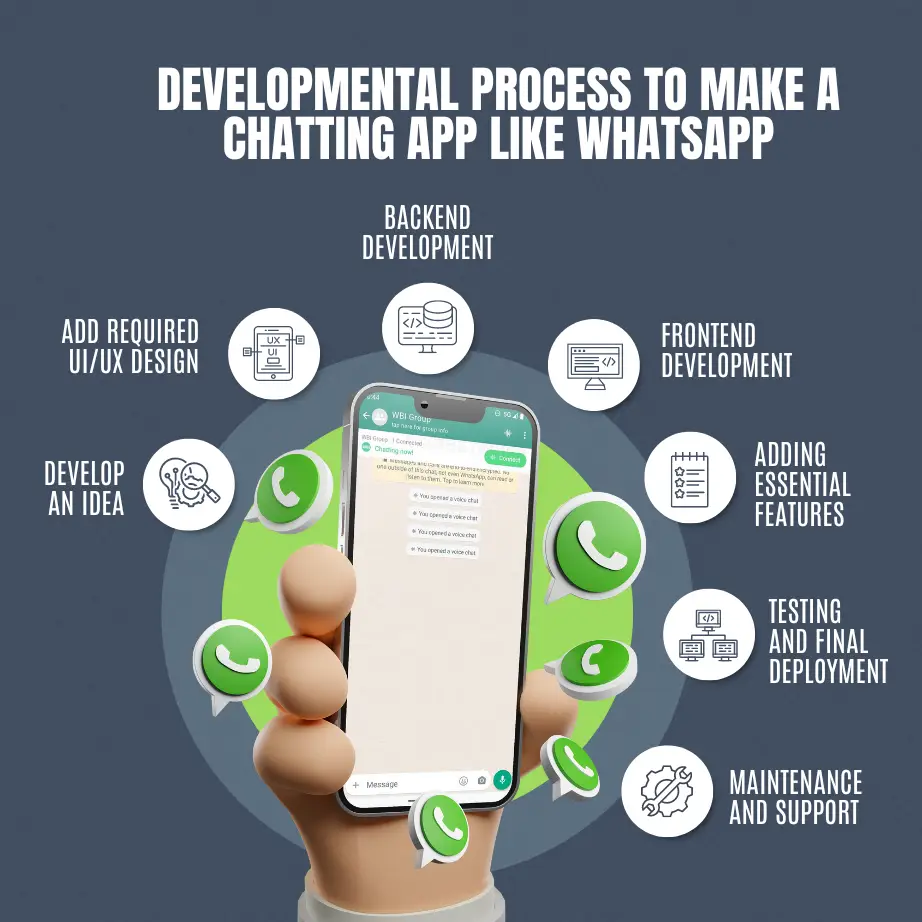
Learn how you can develop an app like WhatsApp with simple steps. Below is a simple step-by-step process by which you can make your messaging app like WhatsApp. Check it out:
Also Read:
1) Develop An Idea
Before beginning the development process, conduct extensive market research to establish your target audience and their preferences. Define your app’s unique selling characteristics and plan your development strategy.
2) Add Required UI/UX Design
Create a user-friendly UI with easy navigation and a compelling user experience. Make sure the design follows the platform-specific guidelines for Android and iOS devices. Contact Echoinnovate IT, a UI/UX Design and Development Company, to integrate the best UI designs in your chat app, such as WhatsApp.
3) Backend Development
Set up your backend infrastructure with a real-time infrastructure-as-a-service, such as. Configure the database, APIs, and other critical components to handle user data and optimise app performance.
4) Frontend Development
Create the front end of your app using the framework and programming language you’ve selected. Use a chat SDK, such as PubNub’s SDKs, to enable real-time conversation in your program.
5) Adding Essential Features
Implement the previously specified key features, including instant messaging, phone and video conversations, end-to-end encryption, push alerts, and contact management.
6) Testing And Final Deployment
Test your app on various devices and operating systems to find and resolve any bugs, performance issues, or security risks. Deploy your program to the program Store, Google Play, or other app marketplaces, following their instructions and restrictions.
7) Maintenance and Support
To keep users interested and the user experience running smoothly, update your software regularly with new features, upgrades, and bug fixes.
Cost And Time Of Developing A WhatsApp App
The cost and time of making a messaging app like WhatsApp depends on multiple factors. Features, platforms, development team, and company make all the difference. To get a rough estimation of the overall cost and time in developing an app like WhatsApp, you may consider the table below for a better understanding:
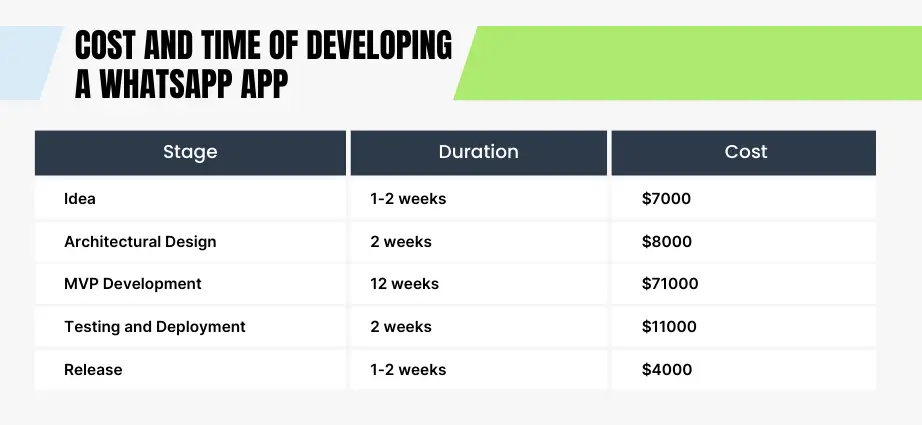
Build An Amazing Messenger App Like WhatsApp In 2024!
WhatsApp has become the leading messaging application and is projected to have three billion active users in 2024. Building a messaging app like WhatsApp can greatly benefit businesses in 2024. The messaging app market has unrealised functions and experiences that the clients will fully engage with.
To kickstart your journey to making a fully functional app chat application, collaborate with Echoinnovate IT, a popular E Commerce App Development and Ionic App Development company based in the USA and India. We can help elaborate on the project and development process, define app functionality based on your goals, and roughly estimate your project cost and timeline. Finally, you’ll have a strong plan for creating a unique messaging application.
Also Read:
FAQs- How To Develop An App Like WhatsApp
What are the key features to include in an app like WhatsApp?
Key features include messaging, voice/video calls, group chats, media sharing, end-to-end encryption, and status updates.
How can one ensure user privacy and security in a WhatsApp-like app?
Implement robust end-to-end encryption protocols, secure user authentication methods, and regular security updates to safeguard user data.
What technologies are essential for building a WhatsApp-like app?
- Utilize programming languages like Swift (iOS) or Kotlin (Android), database systems such as MySQL or MongoDB, and real-time communication protocols like WebSockets.
What is the Google SEO Update 2025?
It’s Google’s latest algorithm focusing on helpful content, AI SEO tools, Core Web Vitals, and mobile-first performance.
How do I rank my website on Google in 2025?
Publish helpful content, optimize Core Web Vitals, build authority with backlinks, and use AI-powered SEO tools.
What are AI SEO tools and how do they help?
Tools like SEMrush AI, Ahrefs, SurferSEO, Clearscope optimize keywords, detect ranking issues, and adapt to algorithm changes.
What is the Helpful Content Update 2025?
Google prioritizes user-first content—not AI spam or keyword stuffing.

